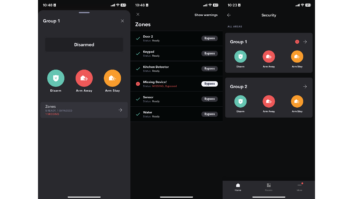If you’ve followed any of my posts on our company’s Mega Job so far, you’ll know that we’re neck deep in the largest project we’ve ever done. (The finish line is actually almost in sight; we delivered all the racks of gear this week.) One of the most important ideas that I’ve learned from this experience is that these larger projects are very fluid and amorphous and that being successful means staying on top of the schedule and managing your time both on and away from the job.

As much as you might want to tunnel-vision your focus solely on the big job–and think how nice it would be to sweep the calendar clear of all other work and tell other people, “I’m sorry, but I’m dealing with a project that is just much more important than yours right now, so unless you are looking to spend a hundred grand or more, you’ll need to wait”–you can’t. The reality is that the phone keeps ringing, other jobs will have issues that need addressing, existing clients will demand your attention, and you can’t abandon everything else in favor of one project.
Here are seven things to remember when attempting to balance a mega job with smaller jobs and day-to-day tasks that in your business.
Communicate with the Builder
On large projects, there are so many different trades in place and often so many people working each day that things are constantly changing with the home. During prewire, you might walk out of a room and return a bit later to find that a new wall has been framed up and nailed into place. Whereas on a smaller job you can (hopefully) count on a builder to (sometimes) keep you informed on changes or when things need to be done, on a massive project the builder will have his plate full with so many other things that the onus of staying on top of things often falls on you. I’ve tried to keep in contact with the builder early and often on this job to make sure that we don’t find ourselves behind the proverbial eight ball. My business partner and I decided early in the job that one of us would stop by the site once a week just to walk through and see what was happening. This helped us stay abreast of things like cut wires, boxes that had been sheet-rocked over, moved or added light cans, etc. If there is something where you are dependent on another trade to accomplish—say, core drilling a hole through a massive section of pressure-treated concrete or getting conduit to a gate-control location—make sure you are on top of this and constantly asking about it or checking up on it.
Befriend Other Trades on the Job
In addition to communicating with the builder, we’ve really befriended the electrician—who worked so closely with us on the Lutron HomeWorks system—cabinet installer and the painting crew. These trades are often at the job every day and have another angle on the schedule, and we’ll often reach out to them directly to ask about scheduling. Building this relationship also helped when we needed them to work with us on something, such as additional power locations or our specific cabinet needs. Further, with them understanding our side of the project a little better and the big picture of what we were trying to accomplish, it helped them to see how their work meshed with ours.
Do What You Can When You Can
One of the difficulties/challenges with being involved in a big job is there are long periods where nothing is happening interspersed with days/weeks where you need all the manpower you can muster and have more work than you can possibly handle. To help cut down on these frantic periods of so much work you feel like you’re trying to drink from a fire hose, be sure to get done whatever you can, when you can. On lots of jobs it is easy to start compiling lists of small things you’ll get to as some point, but on a big job, there are *tons* of these “small things” and they can add up to days of work. We did as much work offsite at our store as possible to cut down on what had to be done at the job. When you have holes in your schedule, fill them with work on the big job.
Leave Holes in Your Schedule
As much as you might want to just draw a big, fat, black line through your job board, rest-of-the-schedule-be-damned, don’t do it. You not only need to leave other days open to service your other clients, but this will also act as a sort of pressure-relief valve to handle any unexpected crisis that inevitably come up. (Thank you, Polar Vortex and recent ice storm, for causing so many electrical surges and system malfunctions!) We have been leaving one to two days open each week to handle other jobs. If we get to those days and nothing else is pressing, we continue on the big job, but it has really helped with the usual tensions of job scheduling to have these planned open days. Also, telling people that they need to wait a couple of days for service is far more palatable than telling them they need to wait a couple of weeks.
HAPWID
This is an acronym I heard many years ago that really stuck with me. It stands for “Have A Plan, Write It Down.” HAPWID has helped our whole team to understand what everyone will be doing on the job, the work we are hoping/expecting to accomplish in a day/week, and a general timeline for what we will be getting done. Instead of the big and vague, “Do housewide audio,” it was “deliver audio racks,” “rack in gear,” “trim out data cabling,” “terminate and connect speaker wiring.” This actually did a lot to relieve my own stress levels on the job, as writing things down allowed me to focus on each step that needed to be done and made it easier to visualize the timeline for the project and what we could get plan on getting done in a specific amount of time. Also, if one of my techs got ahead, they knew what the next step was, or where they could shift over and help someone else.
Be Realistic
There is a horse racing game I play with my daughter, Lauryn, on our Wii. In the game, you whip your horse to make him run faster. Whip him too long/fast, though, and he tires out and stops running and you lose. Don’t whip him enough and he just kind of loafs along and you lose. Unlike a typical project where you finish at the end of each day, on a massive job, you will leave the jobsite almost each and every day with tons more work to do. There will always be something else you could do, or “just one more thing” you could finish up. The key is to (figuratively) whip your crew at a level that will allow them to stay motivated and working without getting burnt out or sloppy from a never-ending series of massively long days. At the same time, there are times when you may need to stay longer to get accomplished what actually *needs* to get done to stay on track. HAPWID helped with this as well, allowing us to focus on bite-sized chunks that were attainable and helping us to feel like we were making progress and accomplishing things.
Be Flexible
“The best-laid plans of mice and men / Often go awry” – Robert Burns
While planning is absolutely essential, the best plan in the world won’t mean that everyone else’s plans will necessarily jibe with *your* plans. I can’t tell you how often we scheduled days on our big job board at work—planning all the work we would accomplish—only to have the painting not be completed, the flooring not finished, the doors not installed, the cabinetry not in, etc. Or we would show up with something in mind only to discover that we needed to shift our focus to something else that needed to be accomplished. It’s also nice to have a back-up plan for other work that can be scheduled in case the days you blocked off your mega project suddenly become open. Being flexible also allows for times when you thought that you could get something done in an hour and it ended up taking three, or when something is added to the job.
While there are a lot of benefits that come from working on a mega job, there can also be a near equal-amount of stress. But with proper planning and attention, you can make sure that you pull off a project of any size like a superstar.

John Sciacca is principal of Custom Theater and Audio in Myrtle Beach, SC.







